The children enteral nutrition market is valued at USD 6,340.4 million in 2025 and is forecasted to reach USD 11,570.8 million by 2035, with a CAGR of 6.2%. Over the first 5 years, from 2021 to 2025, the market grows from USD 4,693.5 million to USD 6,340.4 million. This period sees steady growth as increasing awareness about the nutritional needs of children with medical conditions such as prematurity, metabolic disorders, and other chronic diseases drives demand for enteral nutrition products. Market value increases incrementally, passing through USD 4,984.5 million, 5,293.5 million, 5,621.7 million, and 5,970.3 million during this phase.
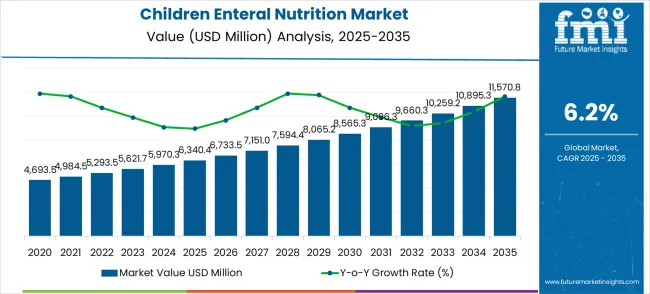
From 2026 to 2030, the market strengthens further, advancing from USD 6,340.4 million to USD 8,065.2 million, passing through USD 6,733.5 million, USD 7,151.0 million, USD 7,594.4 million, and USD 8,065.2 million. Growth during this phase is driven by the continuous development of advanced enteral nutrition products tailored for children, improved healthcare accessibility, and the increasing prevalence of conditions requiring enteral feeding. From 2031 to 2035, the market is projected to reach USD 11,570.8 million, with incremental increases of USD 8,565.3 million, USD 9,096.3 million, USD 9,660.3 million, USD 10,259.2 million, and USD 10,895.3 million.
| Metric | Value |
|---|---|
| Estimated Value in (2025E) | USD 6,340.4 million |
| Forecast Value in (2035F) | USD 11,570.8 million |
| Forecast CAGR (2025 to 2035) | 6.2% |
The hospitals and clinics segment dominates the market, accounting for 50-55%, as enteral nutrition is commonly administered to children with medical conditions like gastrointestinal disorders, prematurity, or severe illnesses that affect their ability to consume adequate nutrition orally. The home care sector contributes 20-25%, as more parents opt for home-based enteral nutrition for children with chronic conditions or long-term feeding needs, providing a comfortable and cost-effective alternative to prolonged hospital stays. Pediatric nutrition centers account for 10-12%, offering specialized enteral nutrition solutions for children with developmental disorders, metabolic conditions, or disabilities, ensuring proper growth and development as part of a comprehensive treatment plan.
The retail and online channels make up 8-10% of the market, as these platforms provide easy access to enteral nutrition products for parents and caregivers, making it more convenient to purchase feeding formulas and related supplies. The nutritional supplement manufacturers contribute 5-8%, producing specialized formulas tailored to children’s specific needs, such as lactose-free, high-protein, or high-calorie options.
Market expansion is being supported by the increasing global prevalence of pediatric malnutrition and the corresponding need for specialized nutritional interventions that can support optimal growth, development, and recovery across various pediatric medical conditions and feeding challenges. Modern healthcare providers and pediatric specialists are increasingly focused on implementing nutrition solutions that can address nutritional gaps, support therapeutic outcomes, and provide comprehensive nutritional support for children with complex medical needs. Children Enteral nutrition products' proven ability to deliver targeted nutrition, enhance clinical outcomes, and support normal development makes them essential components for contemporary pediatric healthcare and therapeutic nutrition programs.
The growing focus on preventive pediatric healthcare and early nutritional intervention is driving demand for children enteral nutrition products that can support healthy growth, prevent dietary deficiencies, and enable comprehensive nutritional management in clinical and home care settings. Healthcare providers' preference for nutrition solutions that combine clinical efficacy with safety profiles and age-appropriate formulations is creating opportunities for innovative pediatric nutrition implementations. The rising influence of evidence-based medicine and personalized nutrition approaches is also contributing to increased adoption of Children Enteral nutrition products that can provide targeted therapeutic nutrition without compromising safety or palatability.
The market is segmented by formula type, application, and region. By formula type, the market is divided into complete formulas, modular formulas, and disease-specific formulas. Based on the application, the market is categorized into online sales and offline sales. Regionally, the market is divided into Asia Pacific, North America, Europe, Latin America, and the Middle East & Africa.
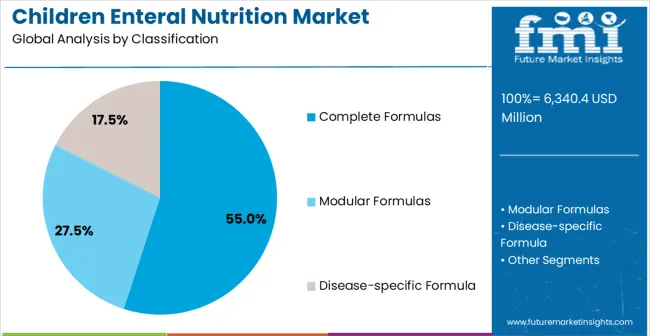
The complete formulas segment is projected to maintain its leading position in the children enteral nutrition market in 2025, capturing 55% of the market share. Healthcare providers and pediatric nutritionists favor complete formulas for their comprehensive nutrient profiles, balanced macronutrient composition, and suitability across various pediatric conditions and age groups. These formulas address the clinical requirements for both therapeutic and general nutritional support in pediatric patients, ensuring effective nutrition management. Complete formula technology, with its evidence-based nutritional design, has established an efficacy record that supports diverse therapeutic applications in pediatric care. With the growing need for comprehensive nutritional support in pediatric care, complete formulas remain central to modern pediatric nutrition strategies.
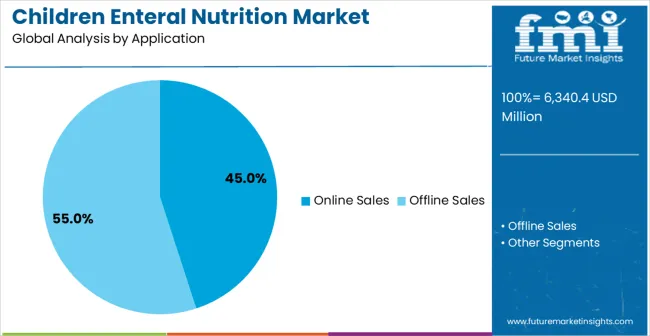
The online sales application segment is projected to account for the largest share of children enteral nutrition demand in 2025, representing 45% of the market. Online platforms have become the primary distribution channel for pediatric nutrition products, offering convenience, comprehensive product information, and consistent product availability. Healthcare consumers prefer online sales for their ability to compare products, access detailed nutritional content, and reduce procurement complexity. E-commerce innovations and specialized pediatric nutrition retailers have made it easier to access healthcare-grade products with improved educational resources and clinical support. The online sales segment is expected to continue dominating, offering enhanced accessibility and convenience in pediatric nutrition sourcing.
The market is advancing rapidly due to the increasing prevalence of pediatric malnutrition and the growing adoption of specialized therapeutic nutrition that provides enhanced clinical outcomes and nutritional support across diverse pediatric medical conditions. The market faces challenges, including high product costs and insurance coverage limitations, regulatory complexity in pediatric nutrition products, and the need for specialized clinical expertise in nutrition management. Innovation in personalized nutrition approaches and digital health integration continues to influence product development and market expansion patterns.
The growing adoption of personalized nutrition approaches and precision medicine integration is enabling healthcare providers to achieve superior clinical outcomes, targeted therapeutic interventions, and individualized nutritional support based on specific patient needs and medical conditions. Personalized nutrition systems provide improved therapeutic effectiveness while allowing more precise nutritional management and consistent outcomes across various pediatric conditions and treatment protocols. Manufacturers are increasingly recognizing the competitive advantages of personalized nutrition capabilities for clinical differentiation and therapeutic optimization.
Modern children enteral nutrition providers are incorporating digital health technologies and remote monitoring systems to enhance patient compliance, enable real-time nutritional assessment, and ensure optimal therapeutic outcomes through continuous care coordination. These technologies improve clinical efficiency while enabling new applications, including telemedicine consultations and predictive nutrition analytics. Advanced digital integration also allows healthcare providers to support comprehensive patient management and clinical monitoring beyond traditional clinical visit-based nutrition care.
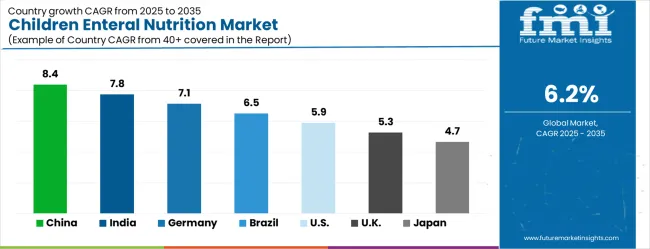
| Country | CAGR (2025-2035) |
|---|---|
| China | 8.4% |
| India | 7.8% |
| Germany | 7.1% |
| Brazil | 6.5% |
| USA | 5.9% |
| UK | 5.3% |
| Japan | 4.7% |
The children enteral nutrition market is experiencing strong growth globally, with China leading at an 8.4% CAGR through 2035, driven by the expanding pediatric healthcare infrastructure, growing awareness of childhood malnutrition, and significant investment in specialized nutrition product development and distribution networks. India follows at 7.8%, supported by a large pediatric population, increasing healthcare access, and growing recognition of the importance of therapeutic nutrition in child health outcomes. Germany shows growth at 7.1%, emphasizing advanced pediatric healthcare standards and comprehensive nutrition therapy protocols. Brazil records 6.5%, focusing on pediatric healthcare improvement and nutrition intervention programs. The USA demonstrates 5.9% growth, supported by an established pediatric healthcare system and focus on evidence-based nutrition therapies. The UK exhibits 5.3% growth, emphasizing pediatric nutrition standards and clinical excellence initiatives. Japan shows 4.7% growth, supported by advanced pediatric medicine and specialized nutrition technologies.
The report covers an in-depth analysis of 40+ countries with top-performing countries highlighted below.
The children enteral nutrition market in China is expected to expand at a CAGR of 8.4% from 2025 to 2035. The country faces a high rate of pediatric malnutrition, which drives demand for enteral feeding solutions. With improvements in healthcare infrastructure and increasing awareness about the benefits of enteral nutrition, more children are receiving treatment for conditions that require specialized feeding. As disposable income increases, families are better able to access quality healthcare services and nutritional products. China’s rapidly advancing medical technologies are contributing to the availability of more effective enteral nutrition formulas.
The children enteral nutrition market in India is forecasted to grow at a CAGR of 7.8% between 2025 and 2035. With a large population and high rates of childhood undernutrition, the demand for enteral nutrition solutions is increasing. Government initiatives aimed at improving child health are also contributing to this growth. Healthcare expansion, both in urban and rural areas, has made enteral feeding products more accessible. Awareness about the importance of proper nutrition in childhood diseases, including malnutrition and gastrointestinal issues, is also on the rise, driving market demand.
The children enteral nutrition market in Germany is projected to expand at a CAGR of 7.1% from 2025 to 2035. As the country’s healthcare system is well-developed, there is a rising adoption of enteral nutrition products due to an increasing number of children diagnosed with chronic illnesses. The growing awareness of proper nutritional care and advancements in pediatric healthcare are fueling the demand for enteral feeding. Germany’s robust pharmaceutical sector is also playing a crucial role in improving the availability and quality of enteral nutrition solutions.
In Brazil, the children enteral nutrition market is expected to grow at a CAGR of 6.5% from 2025 to 2035. The market’s expansion is driven by the high incidence of childhood malnutrition, especially in underprivileged regions. Government and NGO programs focused on improving child health are creating a conducive environment for growth. Moreover, as Brazil's healthcare system continues to develop, more children are receiving specialized care, including enteral nutrition. With increasing awareness of the importance of proper nutrition, enteral feeding is becoming an integral part of pediatric care in the country.
The children enteral nutrition market in the USA is anticipated to expand at a CAGR of 5.9% from 2025 to 2035. The demand for enteral feeding is primarily driven by the increasing prevalence of chronic diseases and gastrointestinal issues among children. As healthcare providers adopt more personalized treatments, enteral nutrition has become an essential part of pediatric care. The rise in healthcare insurance coverage and advancements in nutritional formulas are making enteral feeding products more accessible to a wider population.
Revenue from children enteral nutrition in the UK is growing at a CAGR of 5.3%, driven by the country's focus on pediatric nutrition standards, clinical excellence initiatives, and strong focus on evidence-based nutrition therapy in specialized pediatric healthcare settings. The UK's established pediatric healthcare system and focus on clinical quality are supporting investment in advanced nutrition capabilities throughout major pediatric hospitals and specialized nutrition centers. Industry leaders are establishing comprehensive nutrition therapy systems to serve both NHS requirements and private healthcare markets.
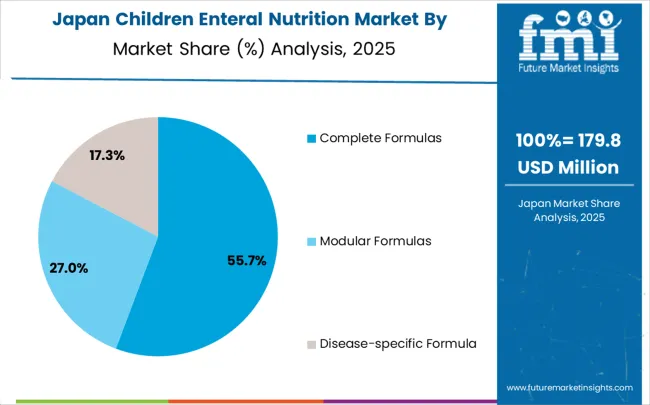
The children enteral nutrition market in Japan is projected to grow at a CAGR of 4.7% from 2025 to 2035. The aging population is driving advancements in pediatric healthcare, with an increasing focus on the nutritional needs of children with medical conditions. Japan’s healthcare system is one of the most advanced in the world, making enteral nutrition products more accessible to families. Moreover, the rising awareness among parents and healthcare professionals about the importance of proper nutrition in managing chronic conditions is expected to fuel market growth.
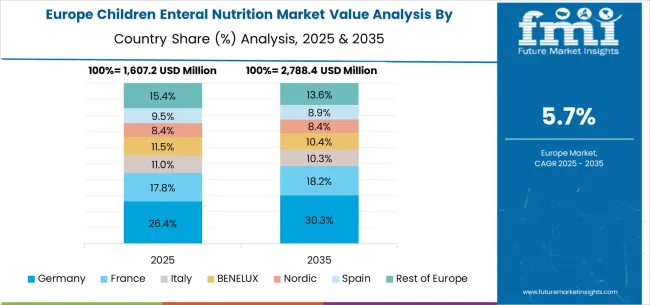
The children enteral nutrition market in Europe is projected to grow from USD 2,346.6 million in 2025 to USD 4,165.8 million by 2035, registering a CAGR of 5.9% over the forecast period. Germany is expected to maintain its leadership position with a 26.0% market share in 2025, moderating slightly to 25.8% by 2035, supported by its strong pediatric healthcare system, advanced clinical nutrition protocols, and comprehensive specialized nutrition infrastructure serving major European markets.
The United Kingdom follows with 21.0% in 2025, projected to reach 20.8% by 2035, driven by established pediatric nutrition standards, comprehensive healthcare coverage, and advanced clinical nutrition programs. France holds 18.0% in 2025, rising to 18.2% by 2035, supported by pediatric healthcare excellence and growing adoption of therapeutic nutrition technologies. Italy commands 14.0% in 2025, projected to reach 14.1% by 2035, while Spain accounts for 9.5% in 2025, expected to reach 9.6% by 2035. The Netherlands maintains a 4.0% share in 2025, growing to 4.1% by 2035. The Rest of Europe region, including Nordic countries, Eastern Europe, and other markets, is anticipated to maintain its position, holding its collective share at 7.5% by 2035, attributed to increasing pediatric healthcare modernization and growing therapeutic nutrition adoption across emerging healthcare markets implementing advanced nutrition standards.
The children enteral nutrition market is characterized by competition among established nutrition manufacturers, specialized pediatric healthcare companies, and integrated clinical nutrition providers. Companies are investing in advanced formula research, clinical evidence development, regulatory compliance, and comprehensive product portfolios to deliver safe, effective, and clinically proven children enteral nutrition solutions. Innovation in personalized nutrition approaches, specialized therapeutic formulations, and digital health integration is central to strengthening market position and competitive advantage.
Nestlé Health Science leads the market with comprehensive pediatric nutrition solutions, offering advanced therapeutic formulas with a focus on clinical efficacy and safety in diverse pediatric conditions. Abbott Nutrition provides specialized pediatric nutrition products with an focus on evidence-based formulations and comprehensive nutritional support. Danone Group delivers innovative nutrition solutions with a focus on specialized pediatric applications and therapeutic effectiveness. Mead Johnson Nutrition specializes in pediatric nutrition research and development with focus on clinical outcomes and safety profiles. Fresenius Kabi focuses on clinical nutrition and therapeutic feeding solutions for hospital and home care applications. Huarui Pharmaceutical offers specialized nutrition products with focus on pediatric therapeutic applications and regional market needs.
Children enteral nutrition represents a critical therapeutic segment within pediatric healthcare, projected to grow from USD 6,340.4 million in 2025 to USD 11,570.8 million by 2035 at a 6.2% CAGR. These specialized nutritional formulations-including complete formulas, modular formulas, and disease-specific formulas-address pediatric malnutrition, feeding disorders, and complex medical conditions requiring therapeutic dietary intervention. Market expansion is driven by increasing prevalence of pediatric malnutrition, growing awareness of specialized nutritional requirements, rising adoption of evidence-based therapeutic nutrition, and expanding access through digital health platforms and online distribution channels.
How could healthcare governments improve Pediatric Nutrition Access and Standards?
How Medical Associations and Pediatric Organizations Could Advance Clinical Standards?
How Nutrition Manufacturers Could Drive Innovation and Access?
How Healthcare Providers Could Optimize Clinical Outcomes?
How Payers and Healthcare Systems Could Enable Market Growth?
How Investors and Financial Enablers Could Unlock Innovation?
| Items | Values |
|---|---|
| Quantitative Units (2025) | USD 6,340.4 Million |
| Formula Type | Complete Formulas, Modular Formulas, Disease-specific Formulas |
| Application | Online Sales, Offline Sales |
| Regions Covered | Asia Pacific, North America, Europe, Latin America, Middle East & Africa |
| Countries Covered | China, India, Germany, Brazil, the United States, the United Kingdom, Japan, and 40+ countries |
| Key Companies Profiled | Nestlé Health Science, Abbott Nutrition, Danone Group, Mead Johnson Nutrition, Fresenius Kabi, and Huarui Pharmaceutical |
| Additional Attributes | Dollar sales by formula type and application category, regional demand trends, competitive landscape, technological advancements in pediatric nutrition formulations, clinical research development, personalized nutrition innovation, and therapeutic effectiveness optimization |
The global children enteral nutrition market is estimated to be valued at USD 6,340.4 million in 2025.
The market size for the children enteral nutrition market is projected to reach USD 11,570.8 million by 2035.
The children enteral nutrition market is expected to grow at a 6.2% CAGR between 2025 and 2035.
The key product types in children enteral nutrition market are complete formulas, modular formulas and disease-specific formula.
In terms of application, online sales segment to command 45.0% share in the children enteral nutrition market in 2025.






Our Research Products

The "Full Research Suite" delivers actionable market intel, deep dives on markets or technologies, so clients act faster, cut risk, and unlock growth.

The Leaderboard benchmarks and ranks top vendors, classifying them as Established Leaders, Leading Challengers, or Disruptors & Challengers.

Locates where complements amplify value and substitutes erode it, forecasting net impact by horizon

We deliver granular, decision-grade intel: market sizing, 5-year forecasts, pricing, adoption, usage, revenue, and operational KPIs—plus competitor tracking, regulation, and value chains—across 60 countries broadly.

Spot the shifts before they hit your P&L. We track inflection points, adoption curves, pricing moves, and ecosystem plays to show where demand is heading, why it is changing, and what to do next across high-growth markets and disruptive tech

Real-time reads of user behavior. We track shifting priorities, perceptions of today’s and next-gen services, and provider experience, then pace how fast tech moves from trial to adoption, blending buyer, consumer, and channel inputs with social signals (#WhySwitch, #UX).

Partner with our analyst team to build a custom report designed around your business priorities. From analysing market trends to assessing competitors or crafting bespoke datasets, we tailor insights to your needs.
Supplier Intelligence
Discovery & Profiling
Capacity & Footprint
Performance & Risk
Compliance & Governance
Commercial Readiness
Who Supplies Whom
Scorecards & Shortlists
Playbooks & Docs
Category Intelligence
Definition & Scope
Demand & Use Cases
Cost Drivers
Market Structure
Supply Chain Map
Trade & Policy
Operating Norms
Deliverables
Buyer Intelligence
Account Basics
Spend & Scope
Procurement Model
Vendor Requirements
Terms & Policies
Entry Strategy
Pain Points & Triggers
Outputs
Pricing Analysis
Benchmarks
Trends
Should-Cost
Indexation
Landed Cost
Commercial Terms
Deliverables
Brand Analysis
Positioning & Value Prop
Share & Presence
Customer Evidence
Go-to-Market
Digital & Reputation
Compliance & Trust
KPIs & Gaps
Outputs
Full Research Suite comprises of:
Market outlook & trends analysis
Interviews & case studies
Strategic recommendations
Vendor profiles & capabilities analysis
5-year forecasts
8 regions and 60+ country-level data splits
Market segment data splits
12 months of continuous data updates
DELIVERED AS:
PDF EXCEL ONLINE
Enteral Nutrition Market Analysis by Product Type, Feeding Route, By Consumer’s Age and End Users Through 2035
Parenteral Nutrition Market Forecast and Outlook 2025 to 2035
Nutritional Bars Market Size and Share Forecast Outlook 2025 to 2035
Enteral Formula Market - Size, Share, and Forecast Outlook 2025 to 2035
Nutritional Yeast Market Size, Growth, and Forecast for 2025 to 2035
Nutritional Labelling Market Trends and Forecast 2025 to 2035
Enteral Feeding Devices Market – Growth, Demand & Forecast 2025 to 2035
Children’s Health Supplement Market Analysis by Product Type, Application and Age Group Through 2025 to 2035.
Children Mattress Market Product Type, Ingredient Type, Sales Channel, and Region - Trends, Growth & Forecast 2025 to 2035
Nutritional Ingredients in Animal Feed Market Trends - Growth & Industry Forecast 2025 to 2035
Nutritional Lipids Market
Nutrition Therapy Market
Enteral Stents Market
Parenteral Packaging Market Size and Share Forecast Outlook 2025 to 2035
Parenteral Formula Market Analysis by Type of Nutrient, Indications and Sale Channels Through 2035
Parenteral Compounding Market Analysis - Share, Size, and Forecast 2025 to 2035
Market Share Breakdown of Parenteral Packaging Industry
Parenteral Drugs Packaging Market
Fish Nutrition Market Size, Growth, and Forecast for 2025 to 2035
GLP-1 Nutritional Support Market Analysis - Size, Share, and Forecast Outlook 2025 to 2035

Thank you!
You will receive an email from our Business Development Manager. Please be sure to check your SPAM/JUNK folder too.
Chat With
MaRIA